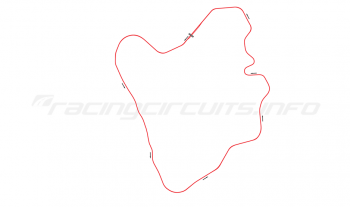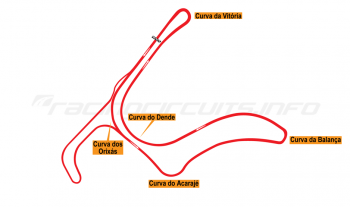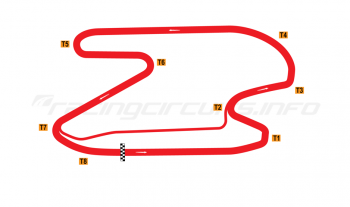Jarama
Circuit Overview
Madrid's Circuito del Jarama (originally known as Circuito Permanente del Jarama) has been at the heart of Spanish motorsport for more than 50 years, home to the senior categories of two and four wheels for many decades.
Located in the northern suburb of San Sebastián de los Reyes, it is owned and operated by the Royal Automobile Club of Spain.
Today the circuit has faded somewhat from international view and its major races are for the domestic touring and motorcycle series, as well as the yearly visit of the FIA European Truck Grand Prix. However, 2022 sees the track welcoming the ETCR eTouring World Cup, the first visit of an FIA-sanctioned world category in several decades.
Circuit History
Despite a long history of motorsport at the highest levels, by the mid-1960s Spain was still without a permanent racing circuit, opting instead to organise its events on street circuits. However, with a developing car industry of its own and a desire to further its motorsport standing, this was an untenable position. In 1964 the Royal Automobile Club of Spain (RACE) began hunting for a location for a permanent circuit, settling on scrubland at San Sebastián on the northern outskirts of Madrid.
Dutchman John Hugenholtz – who had experience of running Zandvoort and in designing the Suzuka and Zolder courses – was brought in to design a course on part of the land, with the remainder being used to form a golf course and country. In truth, the parcel was much smaller than Hugenholtz had wanted and resulted in compact course featuring a number of switchbacks, although with reasonable elevation changes, it still presented some challenges, including a sweeping final turn.
Ground breaking began in 1966 under the direction of Alessandro Rocci, with architects Rodríguez Riveiro and Domínguez Aguado designing the grandstands, pit buildings and imposing control tower, which commanded excellent views of the whole course. Even before the circuit was fully complete, the local appetite to hold a race was such that the first action took place on December 18, 1966, while work continued on pit and spectator facilities. A row of tyres were employed to designate the boundary between pit and circuit. The race was won by Juan Fernández in a Porsche 911.
Jarama rises to the top of the sport
Work was complete by February 1967 and the circuit was officially opened on July 2. Later that month came a GT race followed two days later by the first single seater affair, a Formula 2 event won by Jim Clark's Lotus. The Scot reigned supreme at the end of the year, when the non-championship Spanish Grand Prix was held to Formula One rules in November. It would prove to the forerunner to Jarama's inclusion as part of the World Championship from 1968 onwards, though the track had to alternate with Barcelona's Montjuich Park street course until the latter was deemed unsafe after the 1975 race.
Formula One continued at Jarama, though by the end of the 1970s, what had once seemed a very modern course was now beginning to look a little dated and safety had become a growing concern, with lack of run-off a particular problem. For 1980, modifications were made to the Bugatti esses, shortening the course slightly and increasing the size of the escape area to catch errant cars.
Jarama's Formula One days were numbered nevertheless; it was simply too short and narrow to promote good racing as the final F1 race in 1981 proved, when Gilles Villeneuve kept four cars at bay to win in a considerably slower Ferrari.
The Motorcycle World Championships continued until 1988, having hosting the Spanish round since 1969 (save for 1987, when it was actually the host of the Portuguese Grand Prix!) but thereafter international action was confined to the World Sportscar Championship, two F3000 races and the World Touring Car Championship in 1987.
Refurbishment brings changes
In 1990, the RACE decided to refurbish and extend the circuit, with a revised first corner which increased the length of the main straight and a new section from Ascari to Portago, creating a set of sweeping uphill curves. The pit lane was also extended and new garage facilities added. The changes brought a brief revival in interest from the world motorcycle scene, with two visits from the World Superbikes in 1991 and 1992, before a one-off return of the World Championships in 1998.
Thereafter, the circuit has largely faded into the national scene, with increased competition from a new generation of Spanish circuits taking the limelight. Jerez, Catalunya, Aragon and Navarra have all hosted events that might once have considered Jarama home, though it has occasionally come to the fore with races for FIA GT (2001 and 2002), the Le Mans Series (2001 and 2006) and World Series by Renault (2000-2004).
While Jarama's future at one time looked cloudy, plans announced by the RACE in early 2014 to ensure Jarama retains its place on the national scene, thanks to a seven-year investment programme. A refurbished control tower and grandstand will form the first phase, completed by mid-2015.
Next came the extension of the pit building itself, with two new multipurpose buildings creating a refurbished Paddock Club complex. The former press room, located above six modern pits, allows companies to hold events of more than 300 people, overlooking both sides of the paddock room and the main circuit. A terrace at the top completes this facility.
The final phase, completed in 2020 included the construction of a new welcome and reception space that incorporates a museum to showcase the collection of cars from the RACE Foundation.
The track was also fully resurfaced in August 2018 as part of the refurbishment programme.
In addition to the physical changes to the track facilities, in 2015 the final turn was renamed Curva María de Villota in honour of the Madrid native driver following her death as a result of complications from her Formula One testing crash in 2012. In addition, each year since 2014 the circuit has hosted a foot race over 5km and 10km on Christmas Eve as a fundraiser in her memory.
Jump onboard
Circuit info
- Circuit del Jarama, Autovía A-1 km 28, 28700 San Sebastián de los Reyes, Madrid, Spain
- +34 91 657 08 75
- Email the circuit
- Official website
Rate This Circuit
Votes: 5961
Plan a visit
Get your race tickets!
Brought to you with: 
We've teamed up with Motorsports Tickets to bring you the best deals for Formula One, MotoGP, Le Mans and more.













